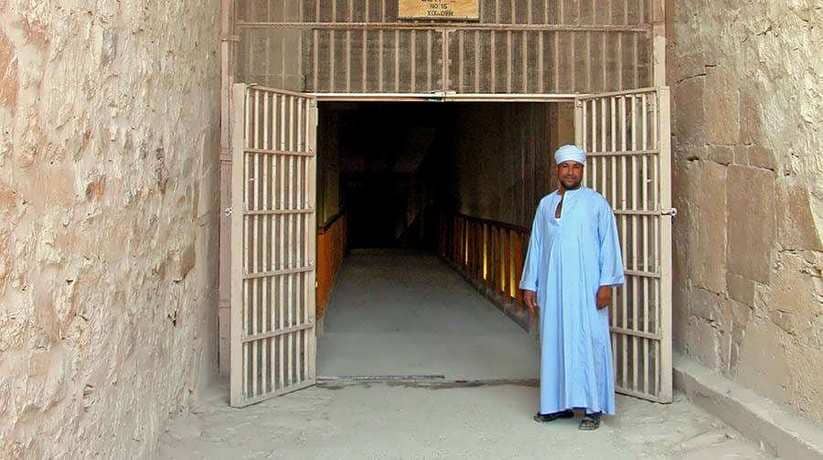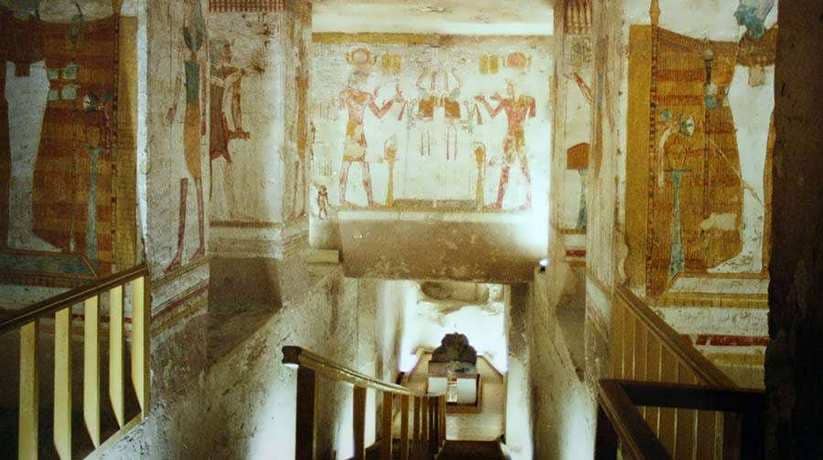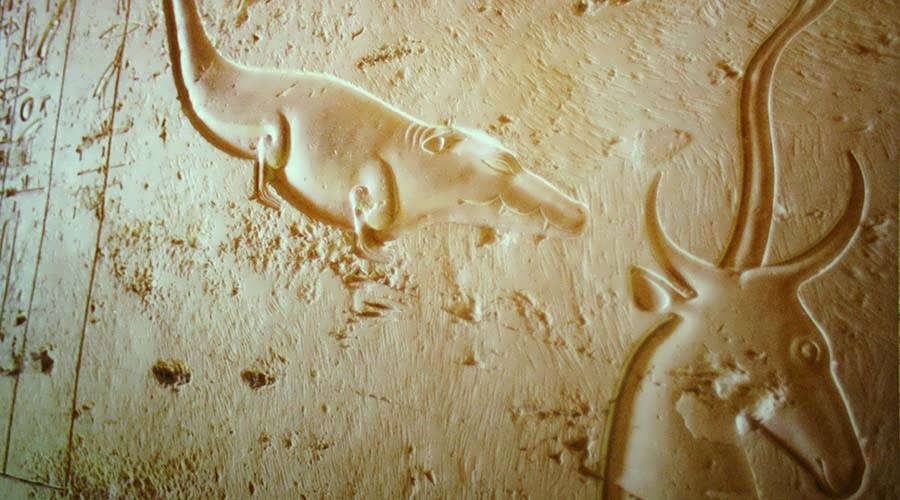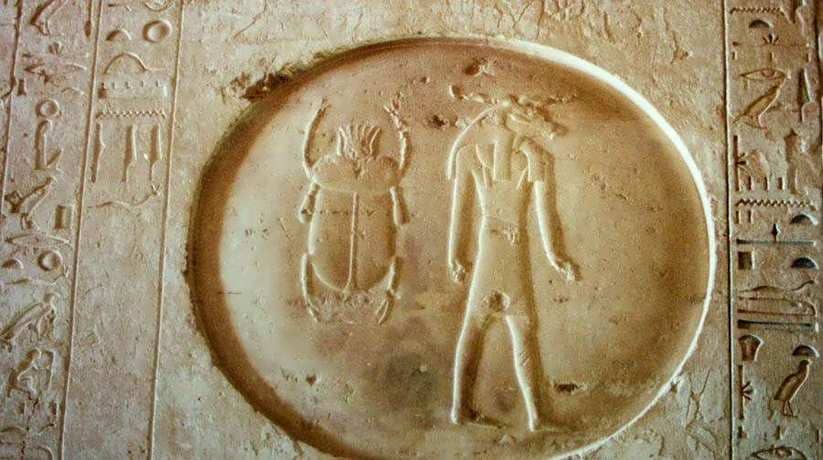Seti II tomb Luxor KV 15 Egypt tours, prices, booking, reviews
Seti II tomb Luxor KV 15 known since antiquity and must have lied open during most of the classical period. It judged from the 59 Greek and Latin graffiti found on its walls. Seti II tomb Luxor investigated by Pococke, along with others who followed after him. In fact, it was Howard Carter who cleared most of the tomb. Moreover, it was between 1903 and 1904. Though the ritual well never excavated. One may find the entrance to the tomb, rather than having steps cut below a retaining wall. It quarried into the base of an almost vertical cliff face. It is at the head of the wadi running south west from the main Valley of the Kings. The history of the tomb is unknown at the time being. It is likely that Seti II maybe buried with his wife, Tausert, in her tomb.
Later he moved to this tomb. Seti II tomb appears to hastily and incompletely finished, by Sethnakht (Setakht). In fact, Seti II tomb Luxor maybe started for Seti II but the work interrupted at some point. Within the tomb, Seti’s name carved, erased, and then carved out once again. The erasure may be because of Amenmeses, or possibly to Siptah. It has suggested that his wife Tausert then had her husband’s name restored. The tomb takes a Northwest to Southeast axis, consists of a short entryway corridor. It followed by three long corridors in turn followed by a well room. The well room then communicates with a four pillared hall and then a makeshift burial chamber. It formed from what would be another corridor. Moreover, it is where the king’s sarcophagus located.
Further more about Seti II tomb Luxor KV 15:
Seti II tomb Luxor is a straight shot which leads 75.38 meters into the cliff face. It is with only a mild descent for the most part leading. Furthermore, it is about 6.53 meters deep, and with no lateral rooms. A rectangular niche on the right side of the pillared hall may mark the location. It is where the usual annex would cut. Missing also is the high trapezoidal niches. They often found at the beginning of the third corridor. Much of the painted decoration is intact and the plaster appears to be stable. None of the well-preserved relief ever painted. Breaks in the surface of the walls have filled in by Antiquities Inspectorate restorers. Due to the hurried completion of Seti II tomb, decorations take two forms. Those in the initial part of the tomb well formed using both sunk and raised reliefs.
They give way to less accomplished work executed in paint only deeper within the tomb. It is with the four pillared hall being the only exception. There, the decorations again revert to sunk reliefs, though paint not always applied. In some of the deepest corridors, only preliminary sketches made on the plaster surface. Throughout Seti II tomb Luxor there are stylistic differences within the craftsmanship of the work. They might suggest the use of different artisans. It is even including the first corridor where we find the raised and sunk reliefs. While the tomb looks unfinished, the walls of the entrance smoothed. They covered with a layer of white plaster, as elsewhere within the tomb. No decorative theme applied to the entrance and entrance corridor walls.
More more about Seti II tomb Luxor KV 15:
The Corridor One on the doorway lintel depicted the kneeling goddesses Isis and Nephthys. Moreover, between them a sun disk with a scarab and a ram headed god. Inscribed on the jambs of the doorway are the names of Seti II. It is with an image of Ma’at which also shown kneeling. Within this corridor, are depictions of Seti II making offerings to Re-Horakhty. They offer vases to Nefertem followed by the initial passages of the Litany of Re on the east wall. The scene of Seti II and Nefertem cut over the original opening vignette of the Litany of Ray. It then re inscribed further down the corridor. On the west wall are scenes of Sokar and Seti II. They make offerings of incense and libations to Re-Horakhty. The rest of the corridor continues with the tests of the Litany of Re.
On the ceiling of this corridor we find painted flying vultures. Some with the head of a cobra and not completely painted. Between the vultures the king’s name inscribed. Along the edges of the ceiling are texts relating to Osiris and Re-Horakhty. The scenes on the next two corridors oriented towards the rear of Seti II tomb Luxor. They are on the eastern walls, while on the west they run towards the tomb’s entrance. Over the outer lintel of the second corridor found a winged disk. It is while on the doorjambs the Litany of Re continued. On the walls off this corridor, the decorative theme executed in red. It is preliminary sketches only. On the east wall we find Seti II making offerings to Re-Horakhty. On the west wall he makes an offering to Sokar. The rest of this corridor continues with sections of the Litany of Re.
Further more about Seti II tomb Luxor KV 15:
Furthermore, it includes the 75 forms of the sun god. Further on, we also find the second and third hours of the Amduat on both the east and west walls. In this corridor, the ceiling once again portrays Isis and Nephthys. They are this time as kites. It is on either side of a sun disk containing the ram headed bird representing the ba (soul) of Re. This scene followed by more text from the Litany of Re. Stars were to have filled the rest of the ceiling, but never completely rendered. The outer lintel of the third corridor decorated with a winged disk. It is while on the door jams we find the names and a depiction of Seti II. Within this corridor, the east wall inscribed with representations. They are from the fourth hour of the Amduat, while the west wall depicts the fifth hour.
Within the well room (ritual shaft) the niches at the entrance, for the first time, cut. Here, an innovation is the depiction of various divine statues. Many imitations of actual wooden figures like those found in Tutankhamun tomb. It supposed we would find the depiction of protective deities. The deities such as the Four Sons of Horus and the related goddesses. But for unexplained reasons these figures have omitted. The walls in the four pillared chamber rendered with the fourth and fifth divisions of the Book of Gates. On the rear wall is a double scene of Seti II. In fact, the scene offers an image of Ma’at and two vases to Osiris. Here, the pillars depict Seti II, Horus-Iwn-mutef and Ptah. Ptah is in a shrine, along with other deities. The innovative decorations on the pillars have only one figure. It is on each side.
More more about Seti II tomb Luxor KV 15:
Two adjacent sides forming a scene. It was a development which used from this time forward. Finally, in the makeshift burial chamber are several registers. The upper of these contain images of Anubis the jackal on a shrine. They also contain two rows of deities representing the followers of Re and Osiris. On the lower registers are scenes of mummified figures on snake style beds. They represent the fifth division of the Book of Gates. Along the length of the ceiling is Nut. It is with down swept wings. Above her head perhaps the remains of depictions of ba of Re. Not much in the way of funerary equipment discovered within Seti II tomb Luxor.
The body of Seti II had removed during antiquity to the tomb of Amenhotep II (KV35). It is along with the mummies of other royalty, for safe keeping. Fragments of his red granite sarcophagus lid were present within this tomb. No trance of the actual box ever discovered. These fragments remain in the tomb. On the top of this sarcophagus is an Osirian depiction of Seti II. The goddess Nut stretches across the reverse side. Unfortunately, the top of the lid is missing, along with the face of the king. The head of the goddess Nut is now in the Egyptian collection at the Louvre in Paris. This is the smallest of any New Kingdom sarcophagus which ever discovered.
Entrance to Seti II tomb Luxor:
The tomb is currently open to visitors. Ticket for the King’s Valley cost 200 Egyptian pound for three Tombs. It includes Seti II tomb. It can bought at the gate. Photography inside the tombs strictly forbidden and can incur heavy fines. There is a little train – Taftaf – that runs from the coach park to the entrance to the monument area. It costs 5 Egyptian pound.
















